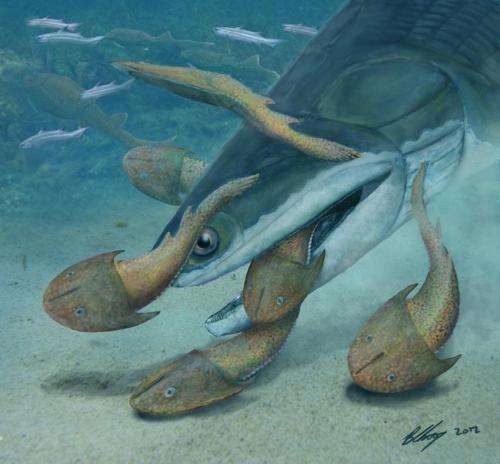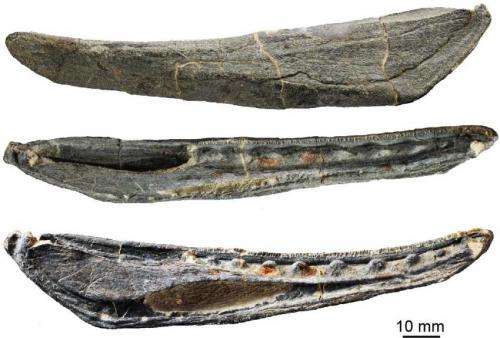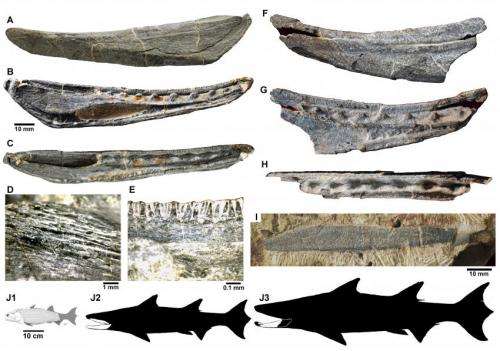June 13, 2014 report
Researchers unearth largest Silurian vertebrate to date—meter long Megamastax

A team of researchers working at China's Kuanti formation has unearthed the largest known example of a jawed vertebrate from the early Dvonian, commonly known as the Silurian period. In their paper published in Scientific Reports, the team describes the predatory fish as being approximately 1 meter long with two types of teeth, one for catching prey, the other for crushing hard shells.
The discovery adds new evidence to the theory that animals with backbones and jaws first developed in what is now China and also disrupts current theories regarding atmospheric oxygen levels during early Earth history. The researchers believe the fish, Big Mouth, Blunt Tooth (Megamastax amblyodus), lived approximately 423 million years ago—a time period that until this new discovery was thought to be characterized by low atmospheric oxygen levels. But a large fish such as Megamastax couldn't survive under such conditions, thus, levels must have been higher.
The find actually consisted of three fossils from three different fish—one a whole lower jaw, the other two, both fragments of an upper jaw—all found at the Yunnan province dig site. The size of the jaw and teeth allowed the researchers to suggest the entire fish, when alive, would have been approximately 1 meter long. The teeth in front were sharp, for grabbing, while those in the back were clearly meant for grinding, likely hard shelled prey. The jaw was approximately 16 cm in length.
-

Megamastax lower jaw: Holotype mandible (IVPP V18499.1) of Megamastax amblyodus gen. et sp. nov. in lateral, lingular, and dorsal views. Credit: Min Zhu -

Fossils of Megamastax amblyodus gen. et sp. nov. (A–E) Holotype mandible (IVPP V18499.1) in (A) lateral, (B) lingular, and (C) dorsal views; close-up of prearticular bone, showing surface ridges (D), and close-up of the marginal dentition in lingual view (E). (F–H) Partial mandible (V18499.2) in (F) lateral, (G) lingular, and (H) dorsal views. (I) Right maxilla (V18499.3) in lateral view. (J) Reconstruction of (i1) Guiyu oneiros alongside hypothetical silhouettes of (J2–3) Megamastax with superimposed fossil outlines. The (J2) smaller fish is based on the V18499.1 and V18499.3, the (J3) larger on V.18499.2. Credit, Min Zhu
The researchers believe the fish was likely the largest predator in its environment—about triple the size of any other known fish from that time period—making it the dominant fish in the sea. During the Silurian period, the part of China where the fish was unearthed was part of the South China Sea. Fossil finds from the region predate jawed vertebrates found anywhere else thus far, suggesting the area was the birthplace of such creatures. They also believe that the reason Megamastax grew so large was because of intense competition between the many types of fish that existed at the time. But making it possible was the amount of oxygen available. Prior to the Silurian period, levels would have been too low. Interestingly, the most recent climate models used to depict early Earth conditions during the same period have also indicated higher atmospheric oxygen levels—this latest fossil find now backs that up.
More information:
Scientific Reports 4, Article number: 5242 DOI: 10.1038/srep05242
Press release: phys.org/wire-news/164107588/s … ent-fossil-fish.html
Journal information: Scientific Reports
© 2014 Phys.org





















